Massachusetts is one of the smaller states in the U.S., and incredibly, 25% of it is covered with water. It contains approximately 3,000 lakes as well as 1,500 miles of coastline with various large bays along it. Easily one of the most popular areas of Massachusetts is Cape Cod, which is home to many different marine animals. The rest of the state is quite diverse with wide coastal plains, river valleys, hills, and forests. If you’re in Massachusetts then you might want to know what some of the largest animals in the state are.
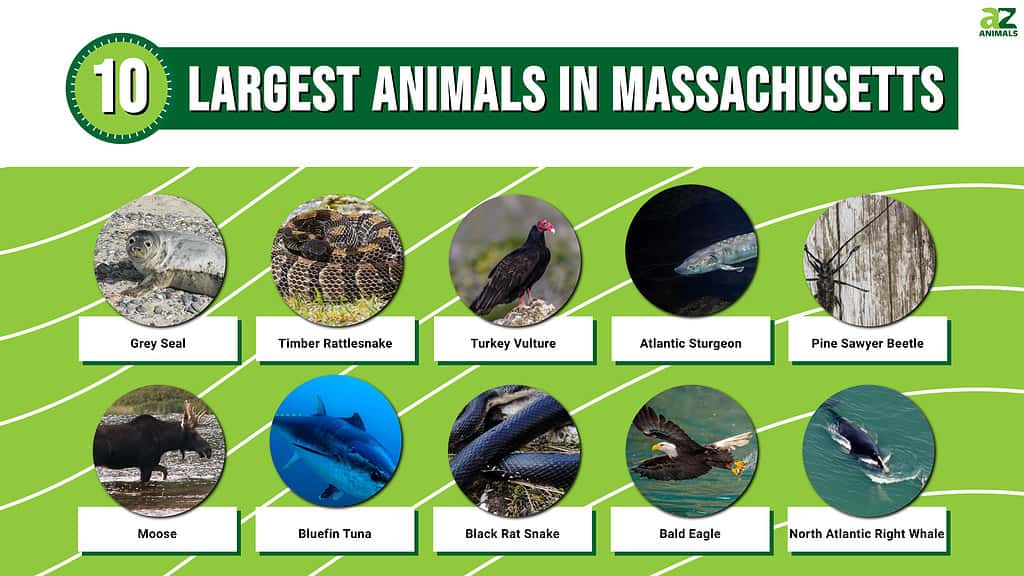
So join us as we discover the 10 largest animals in Massachusetts!
1. Grey Seal

Grey seals can weigh up to 680 pounds
One of the most common seals found in Massachusetts’ waters is the grey seal. Grey seals are large mammals and can weigh up to 680 pounds, with males typically being heavier than females. They are true seals as they have no visible ear flaps and have large, sloping snouts. Grey seals prey mainly on a wide variety of fish, although they also eat octopus and lobster. It is important that grey seals find plenty of food when they can, as females do not eat at all while pregnant or rearing pups. Grey seals are fairly widespread around North America, Canada, and the UK. In Massachusetts, arguably one of the best places to see grey seals is Cape Cod.
2. Timber Rattlesnake
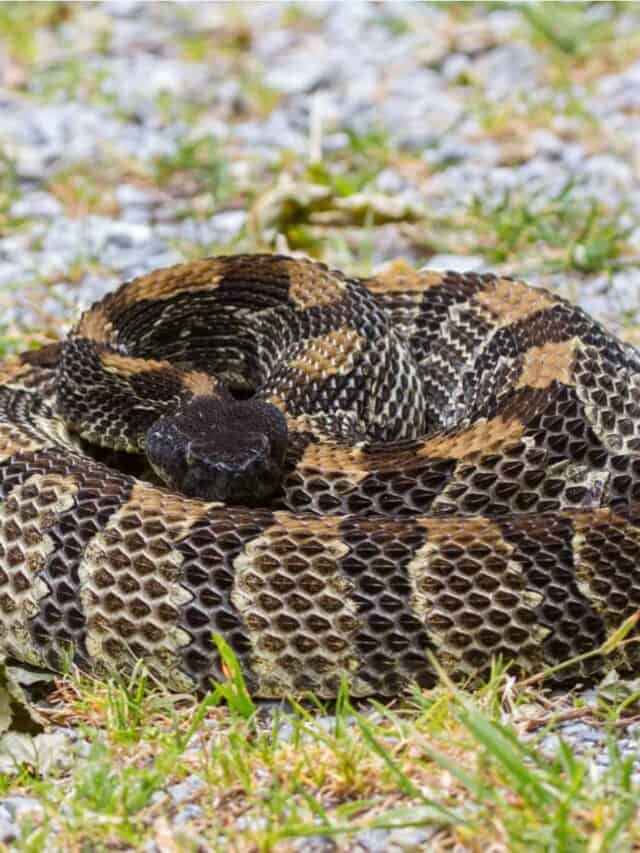
Timber
rattlesnakes
are long venomous snakes, reaching 5 feet
©Frode Jacobsen/Shutterstock.com
The largest venomous snake in Massachusetts is the timber rattlesnake. Timber rattlesnakes reach 3 to 5 feet long and are a yellowish-brown color with brown or black crossbands. They live in thick forested areas although pregnant females prefer rocky ledges where they can bask in the sun. Timber rattlesnakes are incredibly venomous and they contain large amounts of venom. However, luckily they tend to have a fairly calm manner and give plenty of warning before they actually bite. Although timber rattlesnakes are officially classified as Least Concern, they are an endangered species within Massachusetts and populations there have declined more than any other reptile over the last 150 years. It is estimated that there are only a few hundred timber rattlesnakes left in the state and they are found only in the Blue Hills, Berkshire County, and Connecticut River Valley.
3. Turkey Vulture
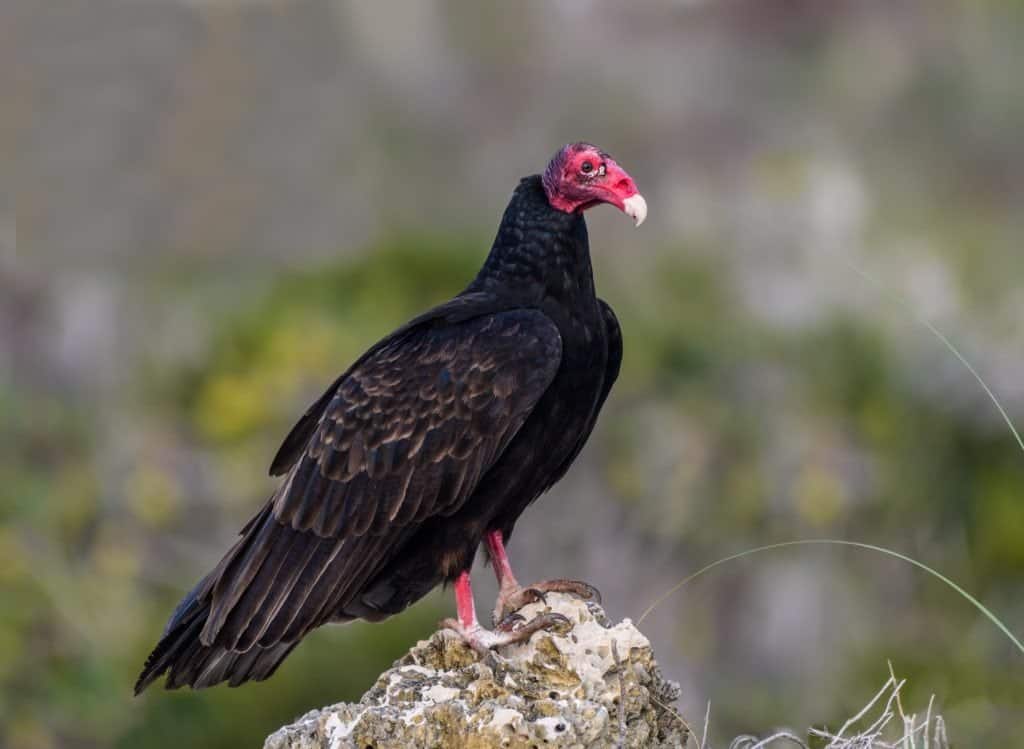
Turkey vultures are large birds with a wingspan of up to 7 feet
©FotoRequest/Shutterstock.com
One of the biggest birds in Massachusetts is the distinctive turkey vulture. Named for their resemblance to a wild turkey, turkey vultures have dark brown or black bodies with bright red heads. Like most vultures, they lack feathers around their head and neck. Turkey vultures have a massive wingspan of 5 to 7 feet and typically soar overhead while scanning the ground below for food, which is primarily carrion. Turkey vultures live in open and semi-open habitats, although they roost in trees in large colonies. They were originally extremely rare in Massachusetts until they began to nest in the state in the 1950’s. Now they are regulars to Massachusetts – especially during the breeding season from March to June – and can be found all over the state in suitable habitats.
4. Atlantic Sturgeon
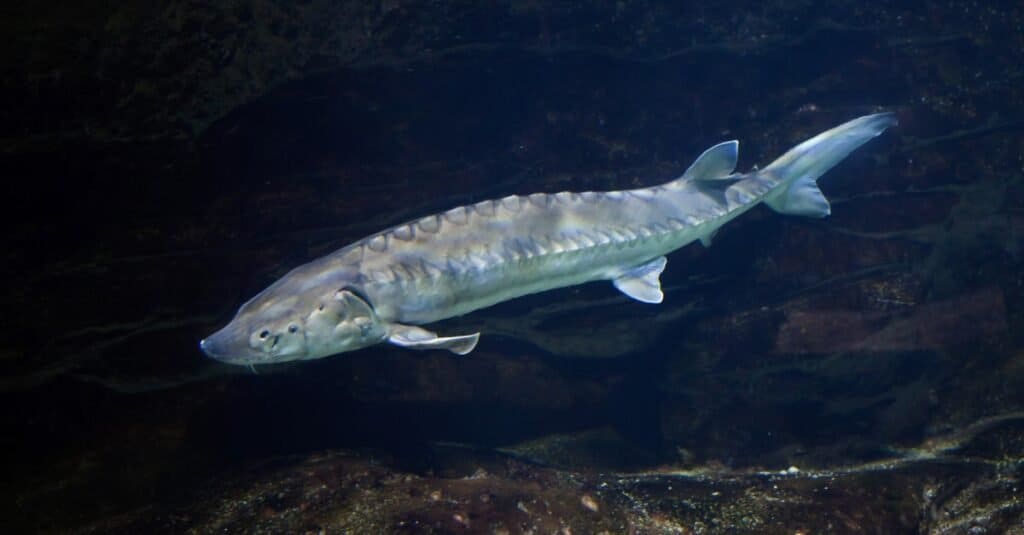
Atlantic sturgeon
can reach 15 feet long and weigh 800 pounds!
©Vladimir Wrangel/Shutterstock.com
Reaching 15 feet long and weighing approximately 800 pounds, Atlantic sturgeon are easily one of the largest fish in Massachusetts. They are olive green or bluish black on their dorsal side and white on their underside. They also have long snouts with varbels on them. Atlantic sturgeon lack typical scales and instead have rows of bony plates down their back which are called “scutes”. Although most adult Atlantic sturgeon live out in the sea, the females travel upstream into fresh or brackish water to lay their eggs. Once hatched, Atlantic sturgeon remain in the waters they were born in until they reach six years of age, after which they travel out into the ocean. In Massachusetts, Atlantic sturgeon can usually be found in the Merrimack and Taunton Rivers.
5. Pine Sawyer Beetle
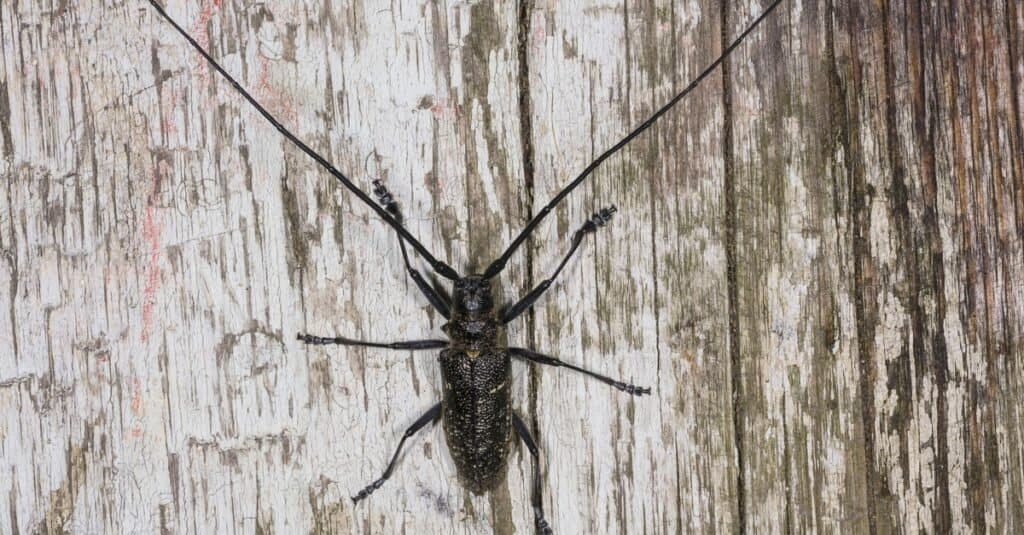
Pine sawyer
beetles
are large beetles which live in coniferous forests
©Mikhail Kochiev/Shutterstock.com
The largest insect in Massachusetts is the pine sawyer beetle which is 2 inches long with 3 inch long antennas. These beetles are brown and grey, often with a mottled appearance. Pine sawyer beetles typically live in coniferous forests at elevations above 3,900 feet. They prefer dead or decaying trees to live in but commonly feed on the twig bark of living trees. Their larvae in particular cause serious damage to living trees due to the holes that they create in them. Pine sawyer beetles are widespread in woodlands across Massachusetts.
6. Moose
The largest land mammal in Massachusetts is the moose which stands up to a huge 6ft 11in at the shoulder. They also typically weigh anywhere up to 1,500 pounds, although there are reports of heavier animals. Moose are herbivores and graze on a variety of grasses and shrubs. However, they also eat aquatic vegetation and are uniquely adapted to do so. This is because they have the ability to close their nostrils using the fatty pads which cover them – meaning that they can graze even while underwater. They are also excellent swimmers and can dive up to 18 feet deep to access food at the bottom of lakes. Moose typically live in scrubland and river valleys where there is plenty of food. One of the best places to see them in Massachusetts is Quabbin Reservoir.
7. Bluefin Tuna
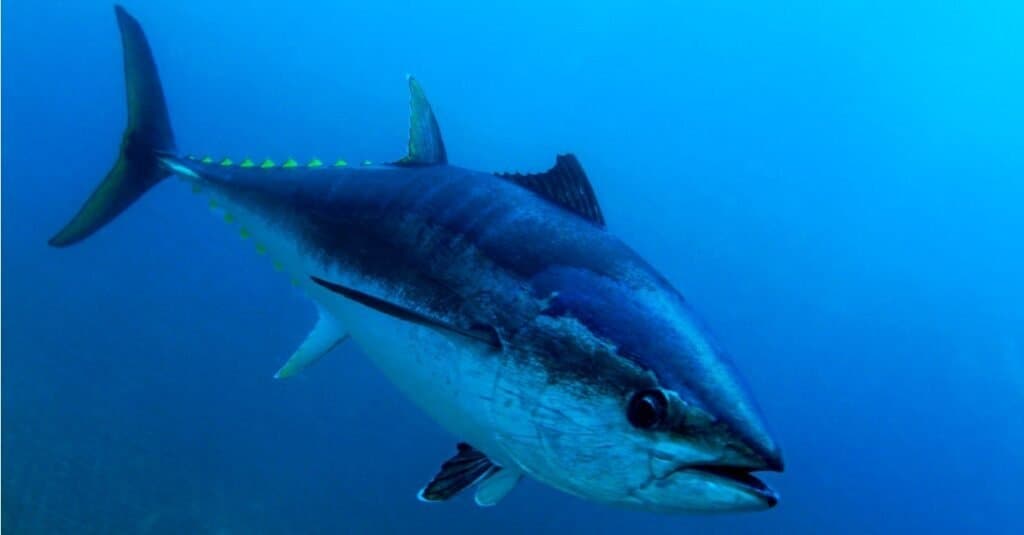
Bluefin tuna are large, powerful fish with torpedo-shaped bodies
©iStock.com/Whitepointer
One of the most stunning fish around is the bluefin tuna. These huge fish are typically 6ft 6in to 8ft 2ins long and weigh between 500 and 550 pounds. However, the largest recorded was 12ft long and weighed an immense 1,500 pounds. Bluefin tuna are torpedo-shaped and are blue on the upper half of their bodies and whitish silver on the lower. They are immensely strong and powerful fish which is why they are one of the most prized fish amongst sport fishermen. Bluefun tuna are highly accomplished predators and eat a wide variety of fish. Sharks and whales are their main natural predators. Bluefin tuna live in the Atlantic Ocean and in the Mediterranean Sea. In Massachusetts one of the best places to find bluefin tuna is Cape Cod.
8. Black Rat Snake

Reaching up to 8 ft. long, black rat snakes are among the longest in N. America.
©Matt Jeppson/Shutterstock.com
The largest snake in Massachusetts (and the whole of North America) is the black rat snake which can reach lengths of up to 8ft 5ins. Black rat snakes are entirely black with the exception of their lips, throat, and chin. They are not venomous and instead kill their prey by constriction. They have a varied diet which includes rodents, lizards, frogs, birds, and even other snakes. Black rat snakes also live in a variety of habitats but tend to prefer woodland areas. They are excellent climbers and can often be seen in the trees. During the winter they hibernate in dens alongside venomous copperheads and timber rattlesnakes. Black rat snakes are now rare in Massachusetts and can now only be found in Connecticut Valley and Worcester County.
9. Bald Eagle
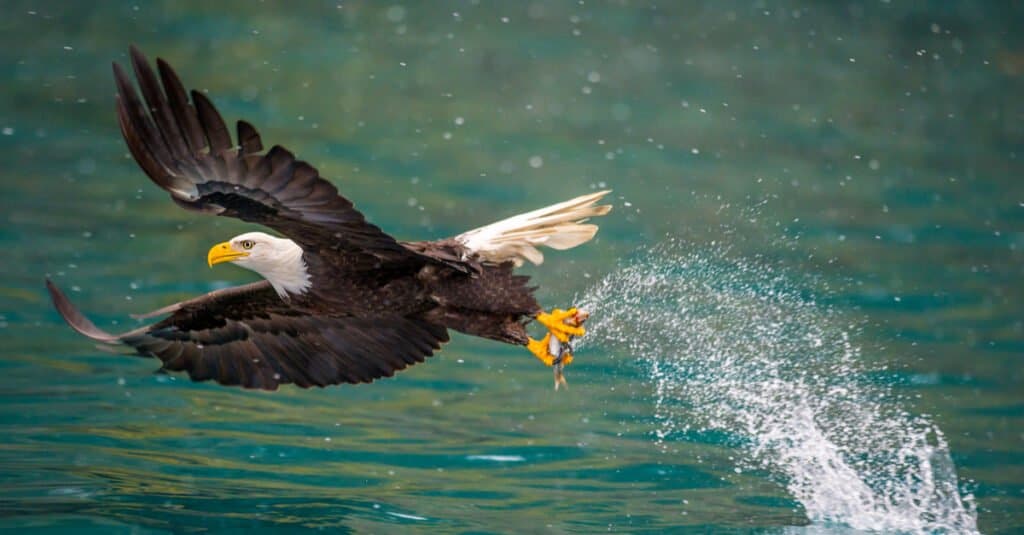
Bald eagles are huge
sea eagles
with a wingspan of more than 7 feet.
©FloridaStock/Shutterstock.com
One of the best known animals in the U.S. is the bald eagle, which is also the largest bird in Massachusetts. Bald eagles are dark brown with white heads and have an immense wingspan of 5ft 11in to 7ft 7ins. However, they are also renowned for building the largest nests of any bird around. Bald eagles just keep adding new material to their nest every year and the largest can end up approximately 20 feet deep and 9 feet wide! Bald eagles are sea eagles and typically live near coastlines and large lakes. Some of the best places to see bald eagles in Massachusetts, especially in winter, are Plum Island and Newburyport. Bald eagles were formally an endangered species in Massachusetts but their population has since recovered enough for that to be changed to “Special Concern”.
10. North Atlantic Right Whale
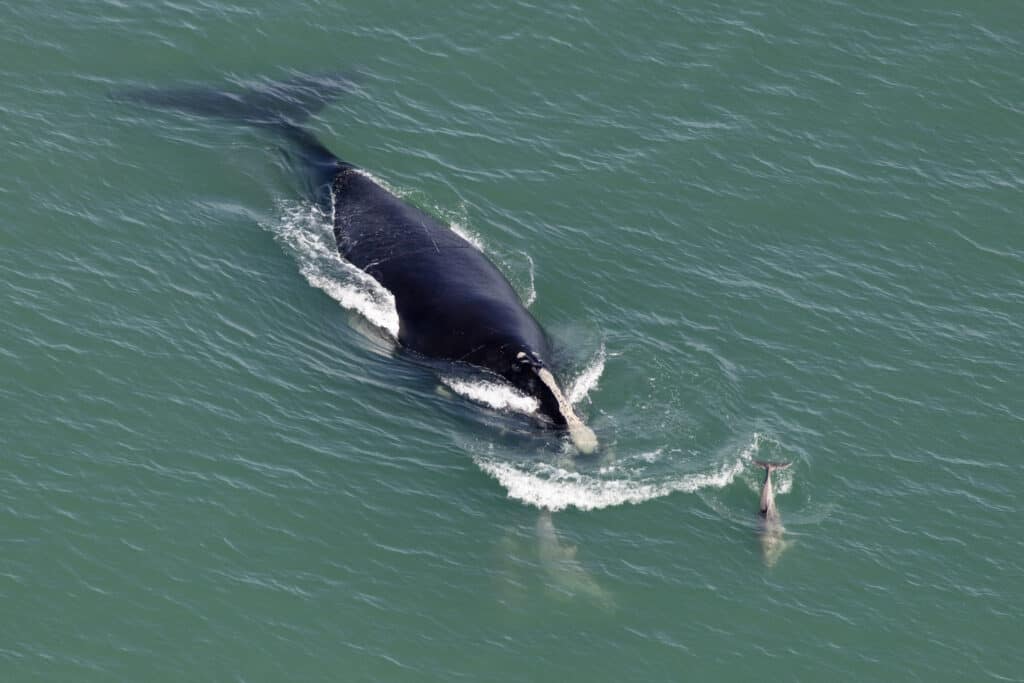
North Atlantic Right Whales are docile, baleen whales that tend to keep close to the coast.
©iStock.com/6381380
There are many whales which live in or visit the waters around Massachusetts and although the humpback whale is the most common, the largest is the North Atlantic right whale. These whales are amongst the most critically endangered animals in the world and to date there are fewer than 350 remaining. North Atlantic right whales are baleen whales and measure 42 to 53 feet long while weighing up to 154,000 pounds. They are filter feeders and mainly eat krill – typically hunting by skimming the water close to the surface. North Atlantic right whales tend to remain close the coastline and regularly show up in Cape Cod Bay in the spring. In spring 2022, Massachusetts was graced with the largest number of these whales in years. Approximately 260 whales arrived – which is around three quarters of the entire world population of North Atlantic right whales!
Summary of the 10 Largest Animals in Massachusetts
| Name of Animal | Size | Habitat |
|---|---|---|
| Grey Seal | up to 680 lbs. | Coastlines, especially Cape Cod. |
| Timber Rattlesnake | 3-5 feet long | Thick, forested areas and rocky outcroppings. |
| Turkey Vulture | 5-7 foot wingspan | Open and semi-open habitats; roost in trees in large colonies. |
| Atlantic Sturgeon | 15 feet long; 800 lbs. | Adults live at sea; eggs laid in fresh or brackish rivers where young live for six years. |
| Pine Sawyer Beetle | 2″ long; antennae 3″ long | Coniferous forests at elevations above 3,900 feet. |
| Moose | 6’11” at shoulders; 1,500+ lbs. | Scrubland and river valleys. |
| Bluefin Tuna | 6’6″-8’2″; 500-550+ lbs. | Atlantic Ocean and Mediterranean Sea |
| Black Rat Snake | 8’5″ long | Woodland areas mostly. |
| Bald Eagle | 7’7″ wingspan; 6.6-14 lbs. | Near large bodies of water. |
| North Atlantic Right Whale | 50-61 feet long; 88,000-154,000 lbs. | Near the coastline. |
The photo featured at the top of this post is © Dolores M. Harvey/Shutterstock.com
Thank you for reading! Have some feedback for us? Contact the AZ Animals editorial team.







